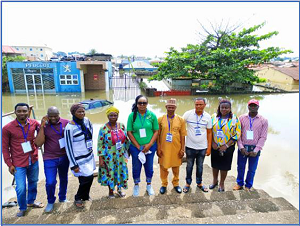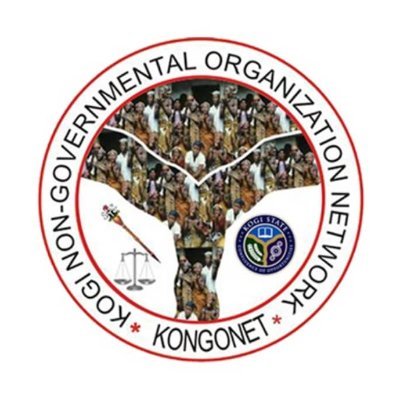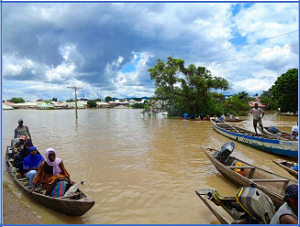The 2022 flood disaster which affected Kogi state marks exactly ten years after a massive flood submerged several communities across nine local government areas in the State in 2012. The waters have returned in 2022 even in a

higher volume wreaking more havoc on vulnerable citizens and residents of the state. The flood has sacked people from their houses and destroyed invaluable properties including crops and farmlands thereby subjecting men and women, school boys and girls to untold hardship.
Lokoja, the State capital and Confluence of Rivers Niger and Benue on Saturday night 24th September 2022 witnessed the rivers overflowing their banks. By Sunday morning thousands of persons have been forced out of their houses to lodge with sympathizers, friends, or relations. Those not too lucky to have such privileged relations, relocated to abandoned buildings and schools in view of the fact that the state government as of 24th September 2022 has not officially set up Internally Displaced Persons (IDP) Camps. This has associated effects on families and individuals exposed not only to hunger and starvation but also the danger of men from the other world such as armed robbers, kidnappers, and rapists as well as the risk of high prevalent malaria due to exposure to mosquitoes.
Prior to this time, the National Meteorological Agency (NiMeT) had predicted that flood would affect a number of States in Nigeria and Kogi was one of the States forecasted to experience flood this year (2022). This information and warning came early enough to allow for adequate preparation by individuals and governments at different levels to minimize damage and destruction the flood would have caused to lives and properties.
Summary Report of on-the-spot Assessment of the Ravaging Flood in Kogi State
Nine (9) Local Government Areas of Kogi State, namely; Ajaokuta, Bassa, Idah, Ibaji, Igalamela-Odolu, Ofu, Kogi-Koto, Omala and Lokoja are currently affected at an alarming rate. Ibaji local government area of Kogi state is totally submerged as at the visit of the KONGONET flood impact rapid assessment team. It is estimated that over 500,000 Kogites across the nine LGAs affected by flood have been displaced, leaving an estimated 12,331 houses built with mud across the local communities destroyed while others are submerged. Over 600 hectares of rice farmlands have been affected and othere major sources of livelihood of Kogites were destroyed.
In Lokoja the Kogi state capital alone, residents of Kabawa, Sarkin Noma, Adankolo, Gaduma, and Ganaja have been submerged and cut off totally from the rest of the state capital. The team assessment revealed that over a thousand houses within the metropolis of Lokoja have been affected as the high tide water is constantly increasing by the day. Many civil servants as well as various workers within the affected communities in Lokoja were caught unaware and could not find their way to their various offices and those who are brave enough went through the aid of canoes to various parts of the state, which is the new normal.
Recommendations
In view of the above numerous observations, the following recommendations have been put forth;
- The government and its agencies responsible for disaster management should as a matter of priority make food items, toiletries, sleeping mats/foams, blankets, and other non-food materials available as matter of urgency to only genuine victims of the disaster.
- The state government in conjunction with other stakeholders should set up well-managed camps with basic amenities such as water, a lighting system, a health care outpost, and free drugs and toiletries to make life more meaningful for victims.
- Kogi state government should urgently deploy its agencies to the various camps to be able to effectively and professionally manage the camps so as to ensure that adequate record of data of the victims is kept and effectively managed.
- The committee highly recommends the inclusion of the traditional rulers in the various affected communities to ensure that actual affected persons are reached out to in the entire disaster management.
- The government at the federal and state levels should make available rescue teams on the waterways as well as provide more safety jackets to ensure the safety of the citizens who have the only option of using the waterways as means of transportation to their homes, businesses, and places of work.
- Government should make available a government-owned and managed water transport system to ensure adequate management and safety of the citizens.
- Kogi state government should as a matter of urgency make a supplementary budget for emergency management and lay same before the legislators in the state for approval so as to be able to effectively respond to the flood disaster and post-flood disaster management.
- In the long run, the federal government must show commitment towards the dredging of lower rivers Niger and Benue to curtail the ravaging flood disaster in the country.
- Lastly, the federal and state government should consider the construction of dams along the rivers Niger and Benue to mitigate the perennial impacts of water released from various dams during the rainy season.
The Kogi NGOs Network (KONGONET) therefore, calls on all well-meaning Nigerians, philanthropists, and international donor organizations to support and provide needed aides to our people, government alone can do it all, and we are grateful to those who had provided support earlier such as Christian Aids and we are calling for more support

